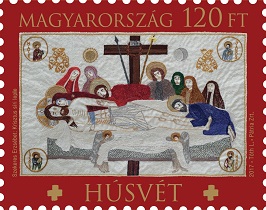
style="display:block"
data-ad-client="ca-pub-6935274628036882"
data-ad-slot="3184055459"
data-ad-format="auto">
1. Magyar - Húsvét 2017
2. English - Easter 2017
1. Magyar - Húsvét 2017
A Magyar Posta hagyományai szerint forgalmi bélyeg kibocsátásával köszönti a kereszténység legnagyobb ünnepét, a húsvétot. A bélyegképen és az alkalmi borítékon Szekeres Erzsébet képző- és textilművész, Krisztus síri leple c. alkotása, illetve annak részlete található. A filatéliai kiadványok Tóth László grafikusművész tervei szerint, öntapadós bélyegként a Pátria Nyomda Zrt.-ben készültek. Az újdonság március 6-tól kapható.
style="display:block"
data-ad-client="ca-pub-6935274628036882"
data-ad-slot="3184055459"
data-ad-format="auto">
Húsvét Jézus halálának és feltámadásának, az emberiség megváltásának ünnepe. A Biblia szerint Jézus Krisztust pénteken feszítették keresztre és a harmadik napon, vasárnap támadt fel. Kereszthalálával megváltotta minden ember bűnét, feltámadásával pedig győzelmet aratott a halál felett. 2017-ben a keleti és a nyugati egyházaknál is azonos napon, április 16-án lesz húsvét ünnepe. A síri leplek története a 12. századig nyúlik vissza. A bizánci görögök által kedvelt késő-középkori temetési ábrázolásokat Hans Belting, nagy Bizánc-kutató művészettörténész szerint a torinói lepel ösztönözhette. A bizánci húsvéti liturgiában használt síri lepel – görögül epitáphios vagy epitáphion – a halott Krisztus, illetve sírba tételének textíliára hímzett vagy festett ikonja. Ma elsősorban a nagypénteki vecsernye során Krisztus sírba helyezésének megjelenítéseként világi hívek közreműködésével a pap hordozza ünnepélyes körmenetben, majd a templom közepén előkészített helyre, a szent sírra helyezik. Nagyszombaton, a feltámadási szertartás alkalmával viszik át a főoltárra, ahol 40 napig, Krisztus mennybemenetelének ünnepéig marad az oltárasztalon.
Szekeres Erzsébet: Krisztus síri leple c. alkotása a gödöllői görögkatolikus Szent Kereszt Templomban található.
Forrás: Posta
style="display:block"
data-ad-client="ca-pub-6935274628036882"
data-ad-slot="3184055459"
data-ad-format="auto">
2. English - Easter 2017
In line with its tradition, Magyar Posta is celebrating Easter, the largest feast of Christianity, by issuing a postage stamp. The stamp and the special envelope reveal the artwork - and a detail of the artwork - entitled Christ's sepulchral shroud, created by artist and textile artist Erzsébet Szekeres. The philatelic publications were produced on the basis of designs created by graphic artist László Tóth as self-adhesive stamps at the Pátria Nyomda Zrt.
style="display:block"
data-ad-client="ca-pub-6935274628036882"
data-ad-slot="3184055459"
data-ad-format="auto">
Easter is the feast of celebrating Jesus' death and resurrection, mankind's redemption. According to the Bible, Jesus Christ was crucified on a Friday, and his resurrection happened on the third day, a Sunday. With his death on the cross, he redeemed the sins of every man, and his resurrection was a victory over death. In 2017, both the Eastern and the Western churches will celebrate Easter on the same day, April 16.
The history of the sepulchral shrouds dates back to the 12th century. According to Hans Belting, a great Byzantium-researcher and art historian, the late-medieval funeral depictions favoured by Byzantine Greeks were inspired by the Shroud of Turin. The sepulchral shroud used in the Byzantine Easter liturgical services - in Greek: epitáphios or epitáphion - is the icon of dead Christ and of his placement into the grave embroidered or painted onto fabric. Today, mainly as a depiction of putting Christ into the tomb, during the Good Friday Vespers - with the involvement of laity - a priest carries it in a solemn procession, then places on a prepared place, the holy grave, in the middle of the church. On Holy Saturday, on the occasion of the resurrection ceremony, it is taken over to the main altar where, for 40 days, it stays on the altar table until the feast of the Ascension of Christ.
Erzsébet Szekeres: Her work entitled Christ's sepulchral shroud can be seen in the Greek Catholic Church of the Holy Cross in Gödöllő.
Source: Hungary Post










